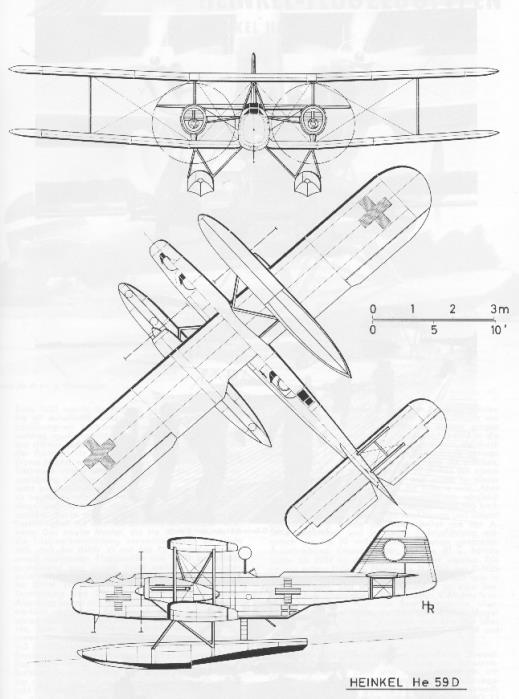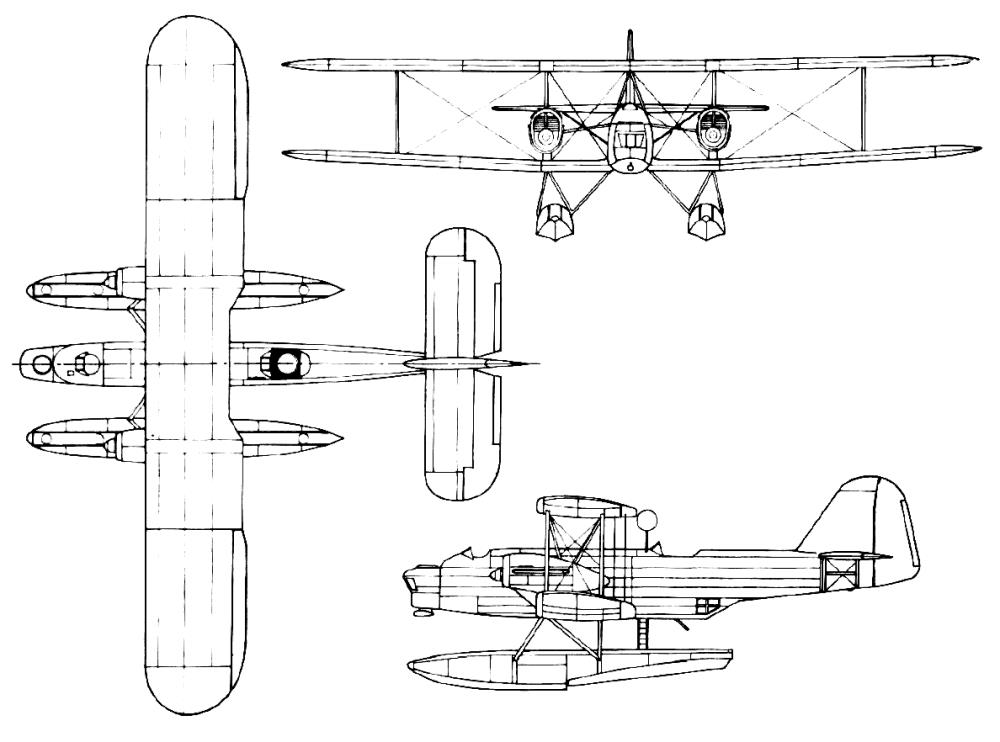| Type |
B-2 4-seat reconnaissance , SAR floatplane |
D 4-seat SAR floatplane |
| Engine |
2 BMW VI 6.0 with 4-bladed fixed-pitch propellers, dia. 3,85 m |
2 BMW VI 6.0 ZU with 4-bladed fixed-pitch propellers, dia 3,85 m |
| Dimensions |
Length 17,4 m , height 7,1 m, span 23,70 m , wing area 153,2 m2, |
Length 17,35 m , height 7,1 m, span 23,70 m , wing area 153,4 m2, |
| Weights |
Empty 5010 kg, loaded 9119 kg , max. take off weight |
Empty 5010 kg, loaded 8950 kg , max. take off weight fuel 775 kg, oil 60 kg |
| Performance |
Max.. speed 221 km/h , cruising speed , range 942 km, ferry range 1530 km with extra tanks endurance , service ceiling 3500 m , climb to 1000 m 4 min. 42 sec., to 2000 m11 min. 12 sec. |
Max.. speed 240 km/h at sea level, 230 km/h at1000 m, 215 km/h at 2000 m, cruising speed 205 km/h at sea level , 200 km/h at 1000 m, 190 km/h at 2000 m, landing speed 88 km/h, range 555 km at sea level , 775 km at 2000 m, ferry range 1530 km with extra tanks endurance , service ceiling 3500 m , climb to 1000 m 4,7 min.,to 2000 m 11,2 min. , to 2000 m11 min. 12 sec. |
| Armament |
3 7.92 mm MG 15 machine guns in nose, dorsal and ventral positions Bombs: 2 × 500 kg , 4 × 250 kg , 20 × 50 kg bombs. 1 800 kg torpedo |
As a sea rescue aircraft no
Heinkel He59N in A-, B- and C-Stond each 1 MG 15 |
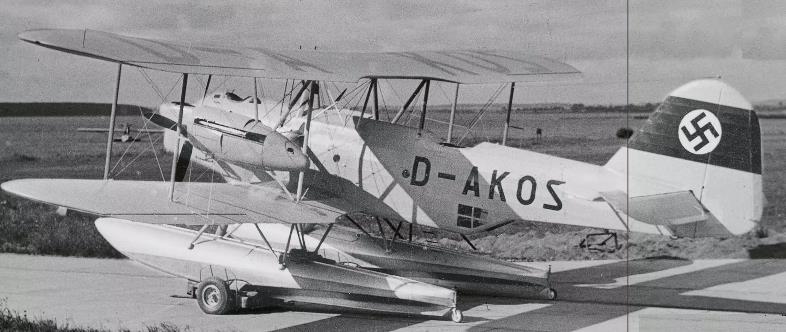
Both models, HD 59a and b, were tested at the test site (E'Stelle) See in Travemiinde. The HD 59b, equipped with a land chassis, then had to undergo further tests at the secret test center Lipzek.The next test model was the Heinkel He 59 B. Series production then began at the Heinkel and Arado companies with the He 59 C and D versions. By 1939, the companies had delivered 163 units to the Luftwaffe.
The first deployment of the He 59 took place in 1936:
27 machines were deployed with the AS/88 naval squadron of the "Condor Legion" in Spain. Three of the He 59s were also fitted with a torpedo launcher, but the results of the tests were not good. Weather reconnaissance over the North Sea. Other machines were used for navigation training. Use in the maritime rescue service In the summer of 1939, the first He 59s were painted white and given red crosses, as they were intended for the unarmed maritime rescue service. However, the machines were given From 1940 onwards, the aircraft were painted and armed again after they were attacked on Churchill's orders because the British suspected that the flights were being used for secret maritime reconnaissance. During the Western campaign and during Operation Weserubung, He 59s flew transport missions. In January 1944, the Luftwaffe had eleven He 59s left. None of the large Heinkel biplanes survived.
The seats for the four-man crew were rather functional and not very comfortable, as the equipment was mainly attached to the tubular construction of the fabric-covered fuselage. The open cockpit was arranged in front of the wings and was slightly raised in front of the nose canopy. In contrast to the HD 59 with its linear instruments, the He 59 C now had standardized round instruments in small and large sizes. Overall, the arrangement was clearer and easier to read. During the day, light came through the windows in the cover above the instrument panel, and there was electric lighting for night flights. The flight monitoring and navigation devices were on the left and the engine controls on the right.instruments. In addition to the location compass, there was also an Askania remote compass system for navigation. In later versions, there were changes in the instrumentation. Individual He 59s also flew with an Askania Lz 11a course control system. The radio operator now had to operate the FuG V with transmitter S 4 and receiver E 4 at the rear. For navigation, there was the Peil G I and also an electric projection compass Plath PHF 2. In the front bow compartment there were two small instrument panels with the most important flight monitoring and navigation devices as well as a folding table with several slots for maps.
The Heinkel He 59 was a twin-engined German biplane designed in 1930, resulting from a requirement for a torpedo bomber and reconnaissance aircraft able to operate on wheeled landing gear or twin-float
In 1930, Ernst Heinkel began developing an aircraft for the Reichsmarine. To conceal the true military intentions, the aircraft was officially a civil aircraft. The He 59B landplane prototype was the first to fly, an event that took place in September 1931, but it was the He 59A floatplane prototype that paved the way for the He 59B initial production model, of which 142 were delivered in three variants. The Heinkel He 59 was a pleasant aircraft to fly; deficiencies noted were weak engines, limited range, small load capability, and insufficient armament.
The aircraft was of a mixed-material construction. The wings were made of a two-beam wooden frame, where the front was covered with plywood and the rest of the wing was covered with fabric.The box-shaped fuselage had a fabric-covered steel frame. The tail section was covered with lightweight metal sheets
The keels of the floats were used as fuel tanks - each one holding 900 l of fuel. Together with the internal fuel tank, the aircraft could hold a total of 2,700 l of fuel. Two fuel tanks could also be placed in the bomb bay, bringing the total fuel capacity up to 3,200 L The propellers were fixed-pitch with four blades.
During the first months of World War II, the He 59 was used as a torpedo- and minelaying aircraft. It was also serving with various Seenotstaffeln (Air Sea Rescue). It also helped land troops in Norway and Holland in the Spring of 1940. Between 1940 and 1941 the aircraft was used by four KüFlGr and in 1941-42 as a transport, air-sea rescue, and training aircraft. Some had been operated by the Condor Legion in Spain during the Spanish Civil War in 1936 as coastal reconnaissance and torpedo floatplanes.
During the Battle of Britain, they were used to rescue German aircrew who had ditched in The Channel. The British claimed that because the air-sea rescue aircraft were being used for reconnaissance, they were legitimate targets despite carrying Red Cross markings. Even before then some had been forced down by British aircraft.
Most of the 140 B-2s and B-3s built by Arado were later converted by the Walter Bachmann Flugzeugbau for air/sea rescue (He 59C-2 and D-1) or specialised training in navigation (He 59C-1, D-1 and N), torpedoe dropping (E-1) and photographic roles (E-2). All of these aircraft were unarmed except for the He 59N.
The Ilmavoimat (Finnish Air Force) rented four aircraft from Germany in August 1943. These were used to ferry long-range reconnaissance patrols behind enemy lines. They were returned to Germany four months later.
Variants
He 59a : First prototype.
He 59b : Second prototype.
He 59A : Test and evaluation aircraft. 14 built. Pre-production version by Heinkel, primarily for testing purposes and for basic training
He 59B-1 : 16 pre-production aircraft.First series production under license at Arado
He 59B-2 : improved version. Second series production at Arado with improved radio equipment. Minor modifications increased the maximum speed to 240 km/h, but the range was only 875 km and the service ceiling 3,500 m. The aircraft were armed with three mobile 7.92 mm MG 15, and from 1937 a 20 mm MG FF in the bow command post. During the war, the armament was further increased: up to two 20 mm MK and two twin MG 81 Z, plus a 675 kg torpedo, four 250 kg bombs or two smoke machines of 375 kg each, as minelayers four 500 kg mines
He 59B-3 : Version as a maritime reconnaissance aircraft. For this purpose, two 500-liter additional tanks were installed in the aircraft's bomb bay to increase the range.
He 59C Series variant with fully glazed hull.
He 59C-1 : Training aircraft for radio operators and navigators
He 59C-2 : Version as a sea rescue aircraft. The machines were converted by the Bachmann company and were given a rear entrance in the C-stand, six inflatable boats and a searchlight in the bow, a new boarding ladder in the rear and a tackle with which shipwrecked people could be hoisted on board from the water. The sea rescue aircraft were unarmed, painted white and bore red crosses.
He 59D-1 : Conversion of existing C-1 with rounded fuselage bow made of light metal for navigator training
He 59D-2 Modified C-1/D-1 with rounded hull bow for navigator training
He 59E-1 : Training aircraft for the use of aerial torpedoes
He 59E-2 : Training aircraft for maritime reconnaissance with three permanently installed series image cameras in the fuselage
He 59N : Modified C-1/D-1 with round bow for navigation training, also mostly conversions.
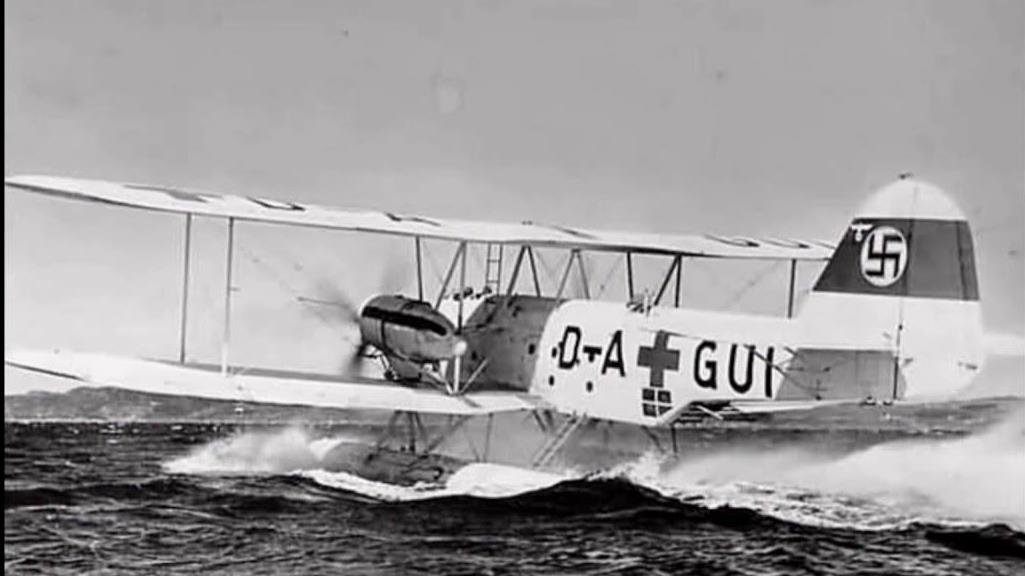
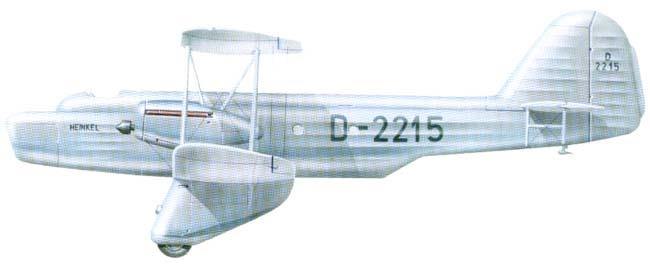
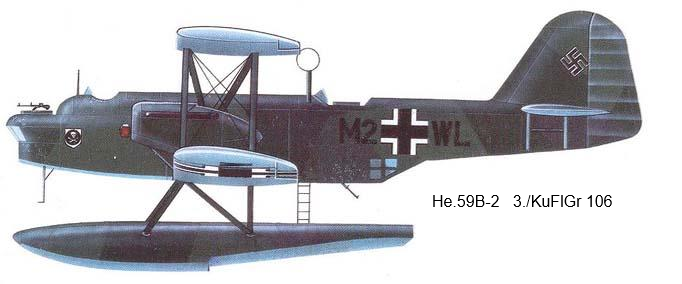
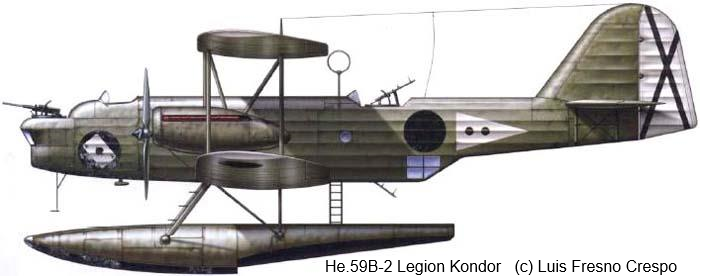
Design description
The He-59 was a twin-engine, four-seater float multipurpose Biplane seaplane of mixed design. The crew of the seaplane consisted of pilot - crew commander, navigator-bombardier, gunner-radio operator and gunner.
The fuselage consisted of three sections - nose, center and tail. Frame The fuselage of the aircraft is welded from steel pipes. Fuselage skin, except for bow section, linen. Plating of the bow section, in which the cockpit was located navigator-bombardier, made of sheet duralumin. It had glazing in front of a large area, a machine-gun turret was opened on top and mounted in the opening. In the cockpit, depending on the modification, a navigation system was installed Equipment of various configurations. In the lower part of the bow compartment on the the elongated rod was equipped with LDPE, and on the right and left sides of the fuselage - pitot pipes.
In the central part of the fuselage there was an open cockpit with a triangular a plexiglass visor. The cockpit was equipped with aerobatic and navigation devices, as well as devices for monitoring the operation of engines. Pilot's seat was adjustable in height. Free space in the fuselage behind the cockpit occupied the bomb bay, which, if necessary, could be used for transportation of people or goods. On the He-59V-3 modification in this compartment It was planned to install two additional fuel tanks with a capacity of 487 each liters each.
In the central part of the fuselage, from below, bomb racks or holders and stops for torpedo suspension. Attached to the middle part of the fuselage were lower wing sections and float struts.
In the rear fuselage there were two more cockpits: the upper open gunner with a turret mount and a lower closed gunner-radio operator with a pivot machine gun mount. The gunner's duties also included getting on board people rescued from the water. On the tail section there was a keel with a rudder directions and stabilizer with elevator. Inside the section there was wiring control of the control surfaces.
The upper and lower wings of the biplane aircraft had a wooden two-spar Design. The spars are box-shaped, the tips are rounded, the skin is linen. Structurally, each of the wings consisted of three sections - center section and pairs of consoles. At the same time, the center sections had a smaller chord than Console.
The ribs of the wing are of truss structure. In the places where the float racks and engine struts installed
reinforced ribs. The ailerons occupied half the span of the trailing edge of each from consoles. Trimmers were installed only on the ailerons of the lower wing. Between the upper and lower wings were connected to the fuselage by a system of struts and braces.
The wing struts were profiled. Braces - steel, cable. On upper wing tips were mounted ANO. On the lower wing engines were installed.
The tail unit is of the classic scheme. The power set was made of steel Pipe. The sheathing of all surfaces is linen. Keel-two-spar design. Along the entire trailing edge of the rudder there was a controlled trimmer. In At the top point of the keel, the antenna mounting rack of the radio station was installed.
In terms of design, the stabilizer practically does not differ from the keel - it is also two-spar. To ensure the required rigidity, each section stabilizer was supported by two struts. The elevators are equipped with steerable trimmers. The rudder and elevator control is flexible, cable.
The take-off and landing gear of the aircraft consists of two all-wood single-rated floats with increased deadrise. Each float was divided into Eight watertight chamber compartments. To control the tightness of these compartments on the surface of floats coated with a special water-repellent compound, there were necks that were closed with lids. At the top of each float With the help of rivets, two duralumin power pads were fixed.
Mooring rings were installed in the front part of the floats, and along the entire length - a rescue rope. The floats contained fuel tanks with a capacity of 854 liters each of them, two in each float. When moving on water, controlling the aircraft was carried out by an aerodynamic rudder and engines (water rudders were absent).
The power plant of the aircraft consisted of two 12-cylinder V-shaped engines water-cooled BMW 6.0 ZU with a take-off power of 660 hp at 1650 rpm and 630 hp at 1530 rpm at an altitude of 2000 meters. The weight of each engine is 542 kg, length 1711 mm, width 859 mm and height 1103 mm and the lower wing. The motor frame, assembled from steel pipes, rested on five support struts, fixed, in turn, to the front and rear spars of the lower Wing. Four struts connected the engine mount to the fuselage and upper wing.
The oil cooler was installed in front of the engine - The engine hoods are easily removable, They provided a good approach to the engine and oil tank, as well as to the fuel automation units. The propellers of the power plant are four-bladed, wooden, with a diameter of 3700 mm.
The engines ran on gasoline with an octane rating of 87. Fuel supply was provided by Pumps. In addition to the fuel tanks, each with 854 liters, located in the floats, to increase the flight range in the bomb bay, two additional tanks with a capacity of 487 liters each.
Electricity consumers were powered by two 12-volt batteries batteries installed in the fuselage.
The equipment of the aircraft included navigation equipment, aerobatic devices and devices for monitoring the operation of the power plant. On all modifications aircraft was equipped with an onboard radio station FuG VIII. radio station was placed between the racks located on the tips of the upper wing and the top of the keel. The loop antenna of the radio semi-compass was installed on top fuselage, in front of the gunner-radio operator's cockpit.
The first aid kit was located in the gunner's cockpit. In the cab The lower gunner housed three rubber rescue boats.
Small arms consisted of three 7.92 mm Rheinmetall-Borsig MG15 machine guns - each had a mass of 8.1 kg and a length of 1090 mm; Rate of fire of the machine gun - 1250 machine guns in the cockpits of the navigator and gunner-radio operator were mounted on the turrets of type "A" and had 975 rounds of ammunition (in 13 disks of 75 each). The machine gun in the lower gunner's cockpit was mounted on a type D pivot mount 15 and had 600 rounds of ammunition. On He-59V-1 aircraft used in of the AS/88 "Condor Legion" squadron, an aviation 20 mm Rheinmetall - Borsig (Oerlikon) MG-FF cannon with a reserve of 75 shells. On He-59V-3 seaplanes, small arms were limited to two machine guns in cockpits of the navigator and gunner-radio operator.
Offensive weapons (weighing up to 1000 kg) were placed in the bomb bay fuselage or on removable bomb racks under the fuselage. Bomb armament - 20x50 kg SC 50 bombs, 4x250 kg SC 250 bombs or 2x500 kg SC 500 bombs. Instead of He-59 bombs could take two LMA mines weighing 500 kg each or one LMB mine weighing 1000 kg. Mines could be equipped with contact or magnetic fuses. Planes The He-59V-1 could also be armed with a 533-mm LF 5f aircraft torpedo weighing 743 kg.
